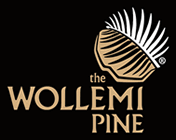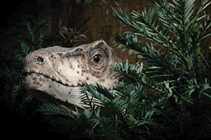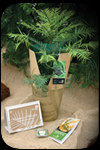It seems in general that the trees need to have -12 to -15 degrees centigrade for fairly long periods to actually kill them (as seen in central Europe in the winter of 2010/11). There have been a handful of reports of trees not surviving this last winter in the UK but on investigation this has been in the main due to the trees already suffering from a fungal root disease called Phytophthora which is a wide spread and very common disease with the ability to affect many garden plants. A simple investigation should give some clues to the demise of your tree. Make a small 'nick' in the bark at the base of the tree and if there are signs of healthy white wood and greening on the inside layer of the bark it could be that the roots are still alive. If there is no sign of life then lift the tree and look at the roots they will be dark brown and there is unlikely to be any white or light brown 'healthy' root. If you hold a root hair in between your fingers and you can slide the outer layer of the root away from the inner core it is a sure sign that the tree has succumbed to Phytophthora.
What can I do?
Unfortunately Phytophthora is a widespread disease and quite hard to control. The addition of green compost into the growing media or soil can help. To our knowledge there are no chemicals available on the retail market to help control or prevent the disease. The Mycorrhizal fungus (Rootgrow) supplied with your tree also helps the root system to fight off Phytophthora but it will not prevent it.
For further information below is the Wiki link to the form of Phytophthora that Wollemi Pines suffer with: http://en.wikipedia.org/wiki/Phytophthora_cinnamomi
Alternatively the Wollemi Pine is known to coppice so if you think the top of the tree is dead or dying but the roots are OK, the best thing to do is remove the top of the tree either 3 inches above soil level or above the healthiest looking branch using sterile secateurs or a pruning saw. The tree will produce a white exudate which should seal the wound. Hopefully if the roots are still alive green buds will develop on the remaining trunk producing a bushy tree. If you want a more upright tree in the future it would be best to choose the strongest leader and remove any side shoots.
How can I give my tree the best chance of surviving a cold winter?
To give the Wollemi Pine the best chance of survival protect it from the worst of the winds during the winter it should flourish if left outside. If you are putting you tree in a container use a 50:50 mix of John Innes no3 and Ericaceous compost. Incorporate some slow release fertiliser into the compost along with the sachet of RootGrow that is supplied with the tree. Westland’s Feed All Slow Release is a suitable fertiliser (please follow the incorporation rates on the fertiliser packaging) Put a layer of crocs (pieces of broken clay pots) into the bottom of the container so that the drainage holes do not block. If it is outside make sure that the container is well drained and raised slightly off of the floor to aid the drainage. The Wollemi Pine starts to need copious amounts of water when the flush of growth arrives in the late spring, until then just make sure that the compost is just kept moist.
The new growth emerging on my Wollemi Pine is bronze or brown in colour.
We assume that because of the extremely cold weather this year that some of the new growth is emerging yellow, bronze or even brown; in the past we have observed that as this growth matures it returns to a green colour. The Wollemi Pine starts to need copious amounts of water when this flush of growth arrives. It may also be worth applying some slow release fertiliser into the soil around your tree. Westland’s Feed All Slow Release is a suitable fertiliser (please follow the incorporation rates on the fertiliser packaging). In the meantime an application of a proprietary liquid fertiliser to the tree will help.
If there is brown tipping on the leaves and you consider it unsightly it can be trimmed off using a sharp pair of scissors, this will have no adverse affect on the overall health of the tree. If the branch is dead it is best to remove it, for large diameter stems and branches (greater than 5cm) use sterile, sharp pruning equipment to match the size of the stem or branch being pruned. We have however seen more mature trees, having lost lower branches naturally start to produce new growth from lower down the trunk and this could be the case with your tree.







